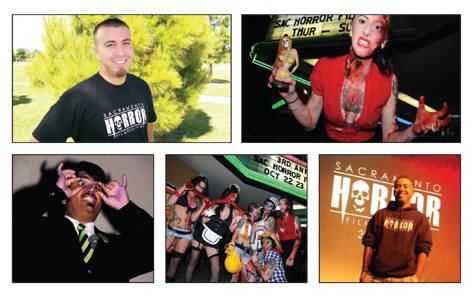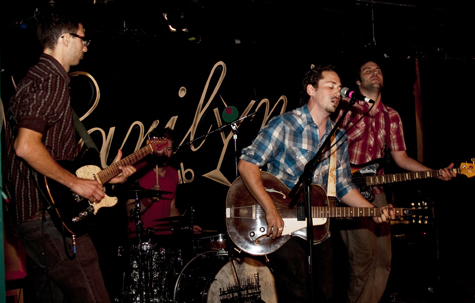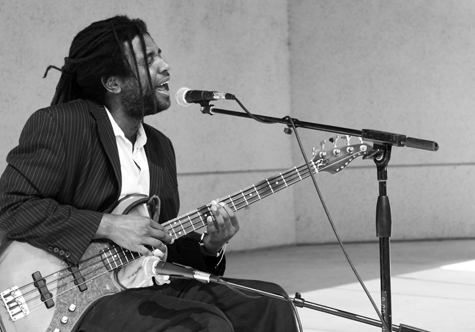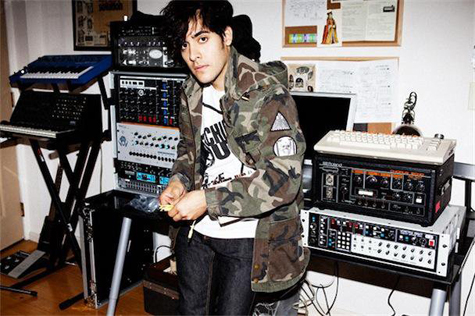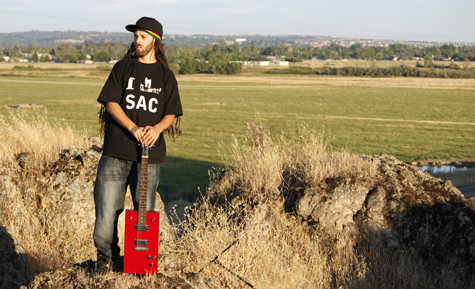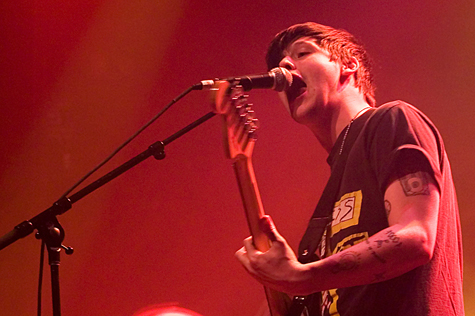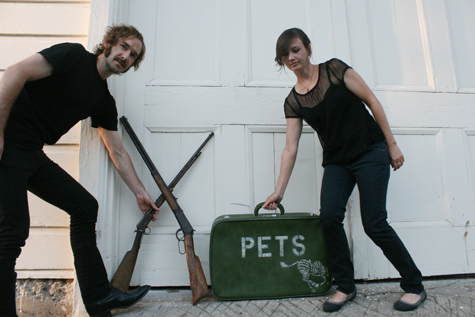The Sacramento Horror Film Festival returns to swallow your soul
Hamsters can make the perfect family pet. They are very cute, very fuzzy and very thirsty for human flesh. The fluffy monsters will kill your friends and terrorize your neighborhood as they cackle and stare into your soul with their beady red eyes. If you turn your back on them, they will eat you from the inside out, showing no mercy. At least they will according to Tim Meunier’s favorite short horror film, Night of the Hell Hamsters. This cheesy horror film, along with hundreds of other frightening flicks, is part of the Sacramento Horror Film Festival, a four-day event that is ready to kick off Halloween. But this is not your average film festival; not only is it fully loaded with independent films, it also contains shorts, documentaries, music videos, animations, live music and even the Zombie Beauty Pageant.
Since 2007, Meunier, the founder, director, programmer and head of staff of the popular growing festival, somehow finds time to work a full-time job and view every single horror film that is entered into the festival–all 4,800 of them!
“I watch every film that rolls through the doors and as soon as the festival is over, I start accepting entries again. So it’s a year-long process,” Meunier said over the phone after working a long, “chaotic” day. “Of course a lot of people wait until the last minute so it gets a little hectic.”
Throughout the year of watching those flicks, Meunier’s trained eye looks past the blood, guts and killer hamsters to catch the numerous aspects of each film. He watches for production quality, editing, acting, direction and most importantly originality of the storyline.
“My goal in the festival is to show entertaining films that you are going to remember and to promote new talent that can hopefully move on to make bigger films,” he added. “Every movie in the festival I am a personal fan of and I think that somebody will like it because I liked it.”
But in a dwindling economy, this horror film lover struggles with cash flow. After five years of finding cash sponsors to support the event, this will be the first year that the entire four days of horror will be funded by Meunier himself. He and his staff also struggle to find appropriate places to advertise for the event.
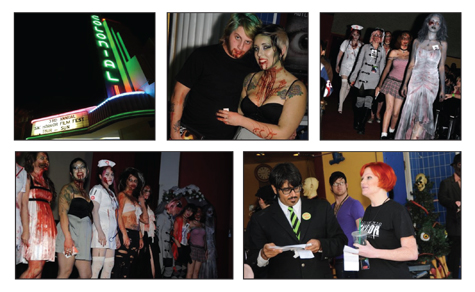
“We’ve been turned away from some businesses because of the type of event. We get treated like the unwanted child of the film festival community,” he said.
Advertisers might be hard to find these days, but the fans are not. Meunier and his staff have garnered a following called the “little horror family” in the Sacramento area. The turnout for the festival has ranged from 1,000 to 2,500 people for one weekend. “It’s like a reunion every year for some of these people and it feels good. We have some die-hard fans.” Every year the staff can expect to see the same faces returning to support the festival. In the past, one Sacramento resident parked his RV in the parking lot in order to be the first person in line for the films and entertainment.
“Our crowd is the Horror Film Festival. I don’t know what it is or if it’s something they put in the popcorn, but we have very vocal crowds, they are very boisterous. It’s almost like all day is a midnight screening,” Meunier said. “It’s not your typical film festival environment.”
The Sacramento Horror Film Festival is one of the many horror related events that have a similar fan base in the Sacramento area, including Trash Film Orgy, Vampire Ball, Rocky Horror Picture Show and Evil Dead: The Musical. “I wouldn’t be able to be doing what I’m doing today without the support of a lot these other groups. I give them props and shout outs,” Meunier said. “Without them I don’t know if I would have had a following. My fans are their fans and their fans are our fans.”
The horror family for the film festival has found a “cozy little joint” to call home at the historical Colonial Theatre. The atmosphere of the old venue speaks for itself. “It’s a one-screen theater, and they have pro-wrestling matches there every month. So sometimes the concrete is a little red-stained from whatever matches they had. It has a creepy, rough environment, so it’s very fitting.”
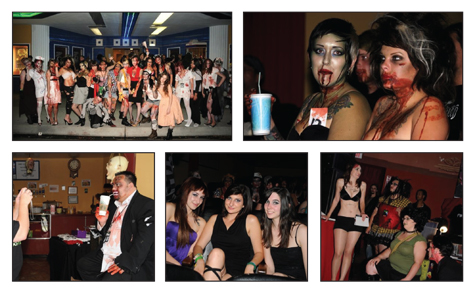
In the beginning, the idea of the festival started off with Tim doing a little research and asking questions of film festival directors around the country, including Greg Ropp, president of the Eerie Horror Film Festival in Pennsylvania and Nathan Schemel, local director of the Sacramento Film and Music Festival. “When I first started I didn’t know there wasn’t a horror film festival in town,” Meuinier said. “I just Googled stuff. I wasn’t involved in the film community that much, I didn’t know if there was a demand for it. I didn’t know if five people were going to show up or 500 people were going to show up.” As a former paranormal activity group member, Meunier found friends that were willing to help out with the cause and after five years he has kept the majority of the same staff members. Over the years, the 32-year-old has learned that some of the best independent or big screen horror flicks have some of the lowest budgets behind them. “A lot of these films require using friends and family. It’s like, ‘Hey mom, do you want to get killed in this scene?’ Even the big Hollywood horror films are nowhere near the budget of the Avatar’s. I don’t know if I’ve ever seen a $150 million horror film,” he said. “But it’s great practice for independent filmmakers to make low-budget films, because they are still going to have to cut corners, even if they make it big.”
Whether it’s Nightmare on Elm Street or Night of the Hell Hamsters, the Sacramento Horror Film Festival wants to leave you with one thought: that horror films are made for an audience to scream at, jump at and even laugh at. “When I get scared I love it. It’s like a drug to me. I don’t drink, I don’t do drugs, I’m addicted to horror. It should never be taken seriously. To me it’s the fun house mirror of society. It’s taking real issues and giving a funny take on it, a unique take, splashing some fake blood on the situation, or amplifying the situation to make it easier to deal with. That’s what the horror film is.”
The Sacramento Horror Film Festival takes over the Colonial Theatre from Oct. 20—23, 2011. Tickets for each event can be purchased a la carte at the door for $10 or an all-events pass will cost just $30. For a full rundown of all that the SHFF has to offer, or to purchase an all-events pass, go to Sachorrorfilmfest.com.
Wires in the Walls, Love Is
Marilyn’s on K – Tuesday, Sept. 27, 2011
We’ve all spent time arguing over the philosophical question, “If a tree falls in a forest and no one is around to hear it, does it still make a sound?” This age-old question was put to the ultimate test last Tuesday night at Marilyn’s in downtown Sacramento, but instead of trees trying to make themselves heard, it was music. When I first entered the bar it was apparent that they predicted a slow night as the cover charge had been lowered from $5 to only $3. Marilyn’s on K is a pretty cozy venue, but the lack of bodies made it seem more spacious than it usually is.
Before headliners Wires in the Walls took the stage, the show started with the soft acoustic sounds of Love Is. And although the frontman was flying solo without his band, he made sure to fill the hollow room with his soothing voice and acoustic guitar riffs. His set was so full of energy and soul it was no surprise that after the show he explained that most of his songs are based on personal experiences and his “spiritual journey” through life. His audience that night only consisted of four people sitting at the bar, a couple playing pool and six people in the crowd. Every once in a while, a loud slam would come from a game of dice with the bartender at the end of the bar. At one point the lead singer acknowledged the few people that were in attendance and took the time to thank the few individuals for coming.
To my surprise, after Love Is’ set was over most of the audience members left to get ready on stage–they turned out to be in the headlining band, Wires in the Walls. But that wasn’t about to stop the Los Angeles-based band from rocking out. Wires in the Walls, who got their name from the Elvis Costello song, “Green Shirt,” started to play catchy folk-rock jams that made it hard not to tap a foot to the beats. Despite the low turnout, the band played with as much energy as they would have to a sold-out crowd, and the lead singer, Warren Sroka, even broke into a small sweat. All five band members owned the stage with their alternative sounds and seemed like they were having a blast. Unlike most shows, the bartender could be heard too easily in the bar and got the chance to talk to the band in-between a few of their songs. During the middle of their set a young woman left her game of dice to place a dollar in the glass tip jar that was near the stage and received a mouthed “thank you” from one of the guitarists. Before they broke into their latest single “New Symmety,” the guitarist placed a camera on top of his head to shoot their new 3D video of the tour.
“Doesn’t he look great in that headpiece?” Sroka asked with a smile. “I find it hard not to laugh.” Wires in the Walls played their entire set and didn’t seem to be bothered that they were only playing for a few people at the bar, in fact they didn’t seem to be phased by it at all. “It doesn’t really matter how packed the place is, it’s how many people you can connect with,” said bass player Nick Tracz after the show. “Despite the crowd we had a great show. We had a ton of fun.” Wires in the Walls proved to be one band that knows how to put on a great show despite the circumstances. So, if a band rocks out on stage and there is barely anyone to hear it, do they still make a sound? The answer is yes: nothing could have stopped Wires in the Walls from being heard that night.
Brian Rogers “Nooner” at University Union Serna Plaza, Sacramento State – Wednesday, Aug. 31, 2011
I had only two goals set in mind for my Wednesday afternoon: eat the homemade peanut butter and jelly sandwich that was shoved in my tote bag and listen to the live acoustic jams of Brian Rogers. After finding a shady spot on the green lawn in University Union Serna Plaza, one of my goals was quickly crushed after I found my once perfected sandwich had turned into a strawberry jam massacre. My meal resembled more of a dog’s chew toy than a sandwich. But I decided to try and ignore my lack of lunch and keep my focus on the local talent that was about to take the stage at Sacramento State University.
Unlike other live shows where the stage is packed with sound equipment, instruments and people, this concrete stage only consisted of a chair, a red bass, acoustic guitar and the suited-up Brian Rogers. Although the weather outside was enough to make your back sweaty, the Sacramento musician was well dressed in black slacks, a light pink shirt and pinstriped blazer. And the small crowd of nearly 30 that were gathered in the shady areas did not hear him complain once about the heat. The audience mostly consisted of students, who were caught eating their lunches, working on homework for the next class or who had just walked by to see what the event was. The volunteers of UNIQUE Programs (organizers of the event), all surrounding a table toward the back of the plaza, were patiently waiting for the show to start and reminisced about the joys of summer.
Originally known from the six-piece band Izabella, Rogers was ready to perform solo for the fifth time at Sacramento State. The only items he needed were his guitar, bass and smooth voice. He boldly decided to kick off the first “nooner” of the semester with a Beatles cover of “Don’t Let Me Down.” For any musician it might be difficult to pull off a cover from one of the most popular bands in rock ‘n’ roll history, but Rogers’ acoustic guitar jams flowed well with the familiar song, and he even added a dash of funk to it.
Normally, this song was no laughing matter but one thing did catch Rogers’ eye that made him chuckle in the middle of the song–a giant dancing lunch box and juice box. No, he wasn’t dreaming or hallucinating but was in the presence of the two mascots for the UNIQUE Programs “nooner,” who were showing off their skilled dance moves. The life-size red lunchbox, Lunchy, with human arms and legs, danced to the jams in the middle of the lawn with his partner, a giant yellow juice box named Juicy. At one point during the middle of his improvised set after the mascots left, he asked, “Where’s the big lunchbox?”
Rogers seemed at ease while performing alone on stage, providing a laid-back and comfortable atmosphere. His songs had a Bob Marley feel to them that could have made anyone want to grab an instrument and play along with him on stage. Before he broke into his original song called “Eyeglasses,” he explained that it was about breaking up with someone and leaving all your belongings at their house, especially leaving behind a daily necessity such as glasses.
“I feel like I should have a sense of humor right now, but I don’t have a sense of humor,” he joked before he broke into another song. During his set, the students in the audience had no need to worry about future deadlines, exams, projects or messed-up peanut butter sandwiches but got to sit back, relax and enjoy live music in the sun.
Demetris Washington becomes a better man through art

Photo by Edgar Guerra
As a toddler, Demetris Washington used to think of the world as his own personal canvas. He started off as would any other child, scribbling on anything and everything he could grasp with his tiny hands. To his mother’s disadvantage he would create pieces of art on the walls, the floor and sometimes even paper. “When I looked at my ultrasound, I was in my mom’s stomach and there was a pencil right next to me. I had a palette and everything,” Washington joked while eating an oatmeal cookie outside of Sugar Plum Vegan Cafe. “When I came out [of the womb] I had a No. 2 pencil. The doctor was like ‘He’s going to be an artist.’”
In elementary school, Washington began to create comics with his own characters that left his family wondering where his imagination would take him next. “I never had fun drawing other characters. I never drew The Hulk, never drew Superman or anything like that,” he said. “I always came up with my own characters. My uncle was always asking, ‘How do you come up with this stuff?’”
While attending high school in Stockton, Calif., the realization that art can become a career started to settle in after he got paid to paint a mural of the school mascot in the boys’ locker room. “I really hyped the team up with that one. Every time they came in [the locker room] I could see their faces lighting up. And I thought, I really like this reaction I’m getting out of them, this is beautiful. People are happy with what I’m doing and I’m getting paid,” Washington said. And while getting his associate degree in graphic design at The Art Institute in Sacramento, he boldly tangled the worlds of comic books and graffiti to form a unique genre of art that he has righteously claimed as BAMR. “Becoming a Man Righteously. For a minute I was really skeptical about this name but when I began to tell people, ‘My name is BAMR,’ they would look at me weird. And that’s the reaction that I wanted, for people to look at me weird but then I tell them what it means,” Washington said.
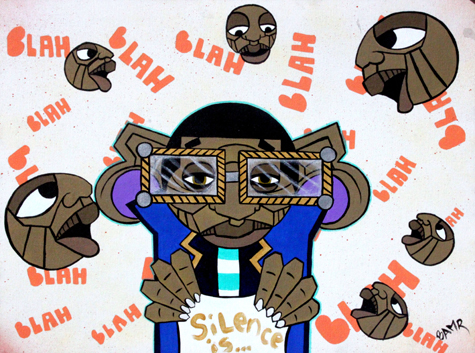
From scribbling on the walls as a toddler to attending art school, Washington has found himself working on projects for the Sacramento Kings, where he would paint on jerseys, shoes and billboards to raise money for charities. Now he has his own show, Building Legacies, at the adorable Legacy Boutique in Midtown. His artwork pops out at you because it is full of colorful characters and shapes that are dying to jump from the canvas and come to life. Although he did not want to draw mainstream cartoon characters as a child, he was inspired by one cartoonist, E. C. Segar, the creator of Popeye.
“If you look at my characters’ arms they look like they ate a little bit of spinach before they went out,” he said with a laugh.
One piece, called Head Above Water (pictured last/used on cover), shows a man with most of his body submerged in water except for his head. The piece represents Washington starting off as an artist who can finally breathe after beginning to make a name for himself and get more freelance work, he said. Most of his vibrant art pieces are based on his life experiences and ideas that he comes up with, normally between the hours of midnight and 5 a.m.
“I do the paintings at night because it seems like that’s when the ideas come to me, when I’m supposed to be asleep, when I’m supposed to be dreaming. It’s like I’m awake but dreaming at the same time,” Washington said. “I don’t need drugs, I got enough in my own mind. That’s another reason why I paint, because I have the hopes that everybody sees what I’m seeing, so I don’t feel crazy… I sit there and I’m literally struggling to stay sane. I’m sitting there painting and all these thoughts and ideas going through my head and nobody to share it with except this canvas.”
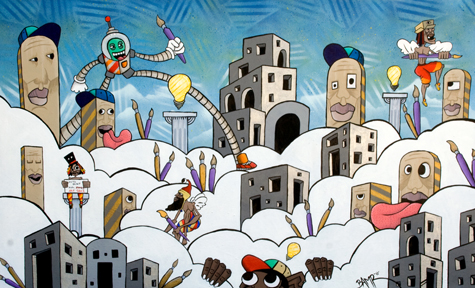
Washington uses his one-car garage as an art studio, which can no longer fit a car in order to store all of the art supplies. But these days he is feeling a bit “too big for the castle” in the small garage and hopes to move to Los Angeles by the beginning of next year and find a bigger studio to work in. After living in so many California cities, such as Monterey, Oakland, Hayward, and Stockton, he doesn’t like to compare the Sacramento art scene with other cities. “I see it as squeezing the last of the toothpaste. Definitely a beautiful place to do art but maybe not as many opportunities for every artist, for every style,” Washington said. “I feel it’s kind of biased. But I’m here, and Sacramento has been good to me, so I’m thankful for it.” Outside of his small Sacramento garage, the 20-year-old freelance artist and graphic designer makes sure to balance his social and work life by finding time to spend with his two young sons.
“They really are the reason why I do everything that I do. I want make an impact on their lives. I wasn’t able to spend so much time with them, because I was working so hard just to make sure they had what they needed,” Washington said. “And I realized what’s more important is the fact that I’m there for them. They get material things but it’s not going to fill in that void where love belongs. So I had to stop for a second, pause and spend more time with them. You can’t become a man righteously if you have two sons that you’re not there for.” But finding time for his family is evident because inside of his sketchbook, which is filled with his own intricate drawings, there are the occasional scribbles from crayons. Washington proudly pointed out the different art techniques that his 2 and 3-year-old sons have created on the pages from coloring with crayons. Demetris encourages his young sons to be creative and let their imagination take over, just like their father’s. “People look at my work and say, ‘Dude how do you come up with this?’ I was going to ask you the same thing. I don’t know how I come up with it. It’s just there.”
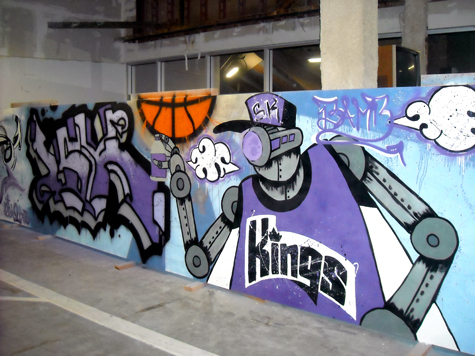
BAMR’s Building Legacies is now showing at Legacy Boutique, 2418 K Street, Sacramento. The exhibit is free and open to the public. For more info, call the boutique at
(916) 706-0481.
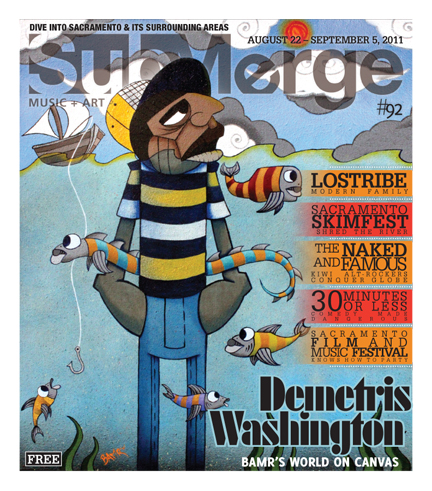
Neon Indian’s Alan Palomo Rides the Chill-Wave Early and Often
Many people aren’t awake at 4 a.m., unless they work a graveyard shift or are still stumbling around after a night of heavy drinking. But before the crack of dawn, Alan Palomo has “crazy, sleepless, caffeine, adrenaline fueled” music sessions. He is busy recording his sophomore album as Neon Indian, while an ample supply of green tea, cigarettes and synthesizers keeps him awake.
“You’ve ever been so tired you think you just heard somebody say your name or you just hear a random sound that wasn’t really there?” Palomo asked. “Your mind starts playing tricks with you and I realized that if you do that long enough and you close your eyes, you literally start to conceptualize these sounds. I like working that way because it takes you to that place.”
Palomo’s seen his late night music jams go from his bedroom to concert venues around the world. Shortly after releasing Psychic Chasms in 2009, he did not expect to receive a huge response from music fans and critics everywhere. However, Neon Indian was named “Best New Music” and ranked Psychic Chasms No. 14 on Pitchfork.com’s “Top 50 Albums of 2009” and was called one of the “Best New Bands of 2010” by Rolling Stone. This past March, Palomo found himself doing what he does best in the early mornings to record a four-song EP with The Flaming Lips.
“We went into it with no particular template set, then it came together in such a nice way. It was definitely a lot of random 4 a.m. nonsense,” Palomo said with a laugh. “And these meditative walls of noise that would just go on all night.”
Originally from Texas, Palomo formerly released music under the name VEGA and was an ex-band member of Ghosthustler before becoming known as Neon Indian. He anticipates the release of his second album in September. “It’s good to be able to put the last little strokes before putting it to bed,” Palomo said. “And finally having this album see the light of day. It’s pretty incredible.”
Many people like to claim his music as one specific genre, such as chill-wave, pop, electronic and even easy listening. But instead of categorizing his music, Palomo tries to leave a sense of mystery in his music to let the listener’s imagination take flight. “There is a beauty to the sort of sonic ambiguity,” said Palomo. “You don’t know exactly what you like about it but overall it creates an effect.”
Submerge caught up with the man of mystery over the phone after he was working on the finishing touches for his next record.
Your first record was pretty much just you and your laptop. Can we expect the same for the second album?
I was definitely hit with that option of just doing another bedroom record. To me, Psychic Chasms is perfectly representative of what was available to me at the time. It was just like, how much can you get out of one synthesizer, a laptop, and a couple of random effects? This one, the location has changed, the circumstances have changed, and the sound has changed too. I have developed a philosophy that I never want to write the same record twice. I always want it to make it feel like the perfect little snapshot of where I am in this particular point in time. And that’s exactly what this record is feeling like.
During the ‘70s and ‘80s your dad was a Mexican pop singer. When you were watching your dad as a kid did you always know you wanted to make music?
Oddly enough growing up, I related a little bit more at least creatively to my mom, who was a film buff. I really wanted to explore that medium at least in whichever way seemed available at the time. In a strange way, writing an album or a collection of songs always sort of feels like filmmaking in that sense. It’s sort of looking at it as one complete concept. It’s like a series of moments or narratives that’s all kind of meant to explain one idea and then move on to the next. That’s sort of the whole foundation of Neon Indian is that there’s not really a template or a way in which it’s supposed to sound, you can always expect it to be its own individual thing every time I do it.
How do you normally get the creative juices flowing when writing music?
I think it takes a lot of cigarettes and for it to be pretty late at night. I have to really create an environment and sort of state of mind to just allow ideas to tumble out. If I’m in a good place, I can finish a song at night, but if it’s just something that I’m forcefully doing, then it’s just like this long grueling process. It happens over the course of several days. I don’t really know. I’m still trying to figure out what exactly it is that puts me in that sort of happy place, so to speak. But when it’s there, I definitely like it.
How did you first fall in love with synthesizers?
I think there was this one keyboard at this pawn shop in San Antonio, Texas, called Krazy Kat Music. It ended up being this thing called the Oberheim OB-X, and I just saw it there. As soon as I flipped it on and just hit the first note, I was overwhelmed at these sensations of childhood and lot of the pop music that I grew up listening to. I think these instruments really do have a way of making these sounds that can create a time and a place or a context, almost out of thin air. I think ever since then, I’ve gotten progressively more and more obsessed.
How was playing on Late Night with Jimmy Fallon?
Very, very surreal. When we were asked to do it, it was literally two days before because, I guess, Kings of Convenience had dropped out. It was a pretty bizarre experience and it ended up being one of the coolest moments of my life. It’s so weird; I don’t really remember it. As soon as [Jimmy Fallon] was holding the record and said our name everything got really slow, and I kind of blacked out. When I look back at it and watch the video, it’s really strange. It’s like I wasn’t even there.
I hate to bring up bad memories but last time you were in Sacramento, there was a little incident with someone stealing your sound equipment. Did you get any of that back?
No unfortunately not. It’s kind of a bummer because the synthesizer that I wrote my first record on is still just out there somewhere. Somebody parked in the wrong hotel parking garage and the next day there was a hole in the window and all of our shit was gone. It was a real damper given that was our first real extensive tour. It was kind of a whirlwind. I’m sure somewhere around Sacramento there’s a synthesizer. It was a signature series Prophet ‘08 synthesizer. It’s somewhat rare. If you turn it on and it has the sound from “Dead Beat Summer” [from Psychic Chasms], then you found it.
S. Carey, Other Lives, Tor House
Wednesday May 25, 2011
Sophia’s Thai Kitchen, Davis
The only barrier that separated the musicians from the audience members at Sophia’s Thai Kitchen in Davis was a white string of lights. The only items that separated the musicians that made up headliner S. Carey were their own instruments, due to the lack of space on the cozy porch stage. The man playing on the porch that night was Sean Carey, best known as the drummer and vocalist from Bon Iver, who made the wooden panels of the porch move Wednesday night.
The show began with an opening set played by Tor House, aka Daryl Jason Lazaro, who stood and sang in front of the other band’s instruments that were piled on the porch. His set only involved him, his guitar, and a few of his number-one fans and friends in the crowd who demanded an encore.
Shortly after Tor House was finished with his encore, Other Lives warmed up for their set. Originally from Oklahoma, the folksy sounding band admitted they were kind of making things up as they went along. Even if they were improvising, they played their soothing acoustic set with ease and seemed to love every minute of it. But during the middle of their set, a group of people near the bar started to have loud conversations that could be heard over the music. At one point the lead singer was strumming his guitar and mildly glaring at the people who were making obnoxious bar noise and said to the quiet people in the front, “Thank you very much for being polite.” Despite the ruckus, Other Lives finished their set to make way for the sounds of S. Carey.

Other Lives
Sean Carey and his band were playing so close together on the small porch that they could have all joined hands while performing if they wanted to. Carey even said that he was glad to play at such a “unique venue.” They started off their set with a low, ambient hum of the combination of the piano, xylophone, bass, drums and guitar, then gradually moved into their songs. S. Carey is the type of band that would be great to have every night in your living room before bedtime to provide sweet lullabies for a good night’s rest. It was mesmerizing to watch the xylophone player balance the four mallets between his fingers as he would hit the different notes on the giant bars. Sean Carey made sure to thank everyone almost after every song and at one point moved his talent from the back of his piano to the front of a drum. Intimacy is hard to achieve at most outdoor shows because the acoustics can get lost in the fresh air. But Carey and his band made each audience member feel as if they were given a one-on-one session with the music. That night’s intimacy was felt in the audience members keeping warm with the surrounding body heat on a chilly night; the dark red glow on each performer’s face that was provided by the only “stage lights” for the show; the street light turning on in the middle of the set, providing S. Carey a little more stage light for their performance; the crowd of 30 feeling the porch pulsate beneath them while they held Chimay glasses and beer bottles at their side.
Anyone can listen to the music of S. Carey on an iPod, in a video on YouTube, or in the car, but nothing can beat feeling the music on a small porch in Davis.
José Luis Villegas’ new exhibit Save the Music showcases an American art form
Words by Amy Serna
José Luis Villegas remembers the first moment he ever captured in a photograph. It was a self-portrait of him lying on his front yard at 16 years old. He set the self-timer on the Minolta 35mm camera that his father bought at a pawnshop, then posed with “a subtle smile” for his first photo op. That small interest he had in photography during high school later turned into a career that has lasted for 27 years, including his current job as a photojournalist for the Sacramento Bee. But one year before he started his job at the Bee, something caught his eye in the newsprint. He became moved by an article he read about an old blues musician that had passed away, and he got an idea.
“It kind of lit a light bulb in me, I started doing a little bit of research, back before we had access to computers, so a lot of it was going to the library,” Villegas said while sitting in the Viewpoint Photographic Art Center in downtown Sacramento. The little “light bulb” in his head would soon lead him to photographing some of the most influential blues musicians in the world. During his off time from his day job at the newspaper, he would be in contact with representatives of musicians that were coming through California and tell them about his vision.
“Little by little the doors began to open,” Villegas said. “And outside of some of the concert pictures, my real goal was to get access to photograph some of the activity that took place backstage and just try to get a little slice of what life was like for an older musician.”
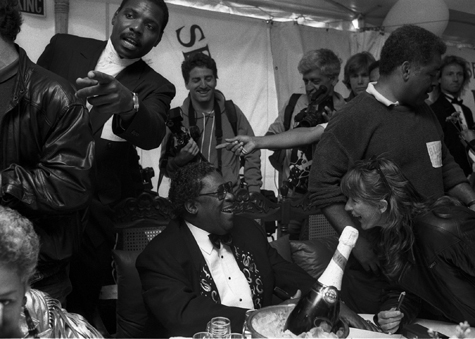
BB King - Concord, California 1991
Throughout the years, starting in 1991, Jose has captured various moments in the world of blues music that isn’t just another concert image–it’s “appreciation” of blues music. For every photo displayed throughout the gallery, there is a moment frozen in time with an experience, an encounter or a performance with legendary musicians. “Some of them were very comfortable with where they were in their lives and were more interested in just playing the music,” he said. “And were more taken by the fact that people were still interested in their music, this many years down the line.”
Each memory and story that Villegas has about his blues experience can be clearly seen in each of his photographs. He vividly remembers that blues legend John Lee Hooker liked to have attractive young women at his side. He remembers the type of “aura” that B.B. King had when he was in his hotel room while surrounded by reporters or at a party where King was the center of attention. He recalls talking to Sunnyland Slim, a man in his 80s who was still performing a 45-minute set and remembers the way he was “slouching a little bit in his seat” at a night club.
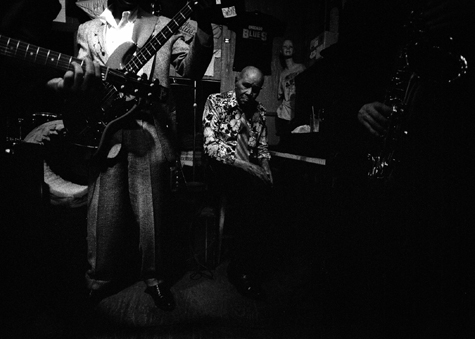
Sunnyland Slim - Chicago, Illinois. 1992
“The image was already there,” Villegas said. “And [the moment] happened several times during the course of the night. It was just a question of whether I recognized the moment and was able to compose it the way I wanted to.”
All of these memories are now black and white and color photographs for the Save the Music exhibit at the Viewpoint Photographic Art Center in Sacramento. The gallery of photos will give you a glimpse of the experiences of blues musicians with scenes from concerts, birthday parties and backstage chats. “I would hope that the photographs would speak for themselves,” Villegas added. “[People] get to see the artists more as people who enjoy what they’ve been doing for a long time.”
One photo in particular, of the more popular, Charles Brown–a blues singer in his 70s who was living in an elderly home then rediscovered by Bonnie Raitt–was taken in 1991 in Monterey, Calif. The photo has an up-close and personal feel; it almost feels as if you are sitting right next to Brown watching him play.

Charles Brown - Monterey, California 1991
“In journalism or in street photography, I think the idea is to try and get yourself in a position where you can document a moment in time that hopefully will translate to somebody else as if they were there,” Villegas said, standing in front of his photos. “A moment that is spontaneous, that has captured a little bit of emotion, a feeling, and if I can get someone to feel something from that imagery, then I think I’ve accomplished what I’d set out to trying to do.”
The 51 year-old man who captured these “spontaneous” moments in his photographs is no stranger to the world of art galleries. Although this is the first time Villegas will be showing at the Viewpoint, he isn’t going to sweat during the exhibit opening because of previous experience including The Oakland Museum, Museum of Modern Art in Texas, the Baseball Hall of Fame in Cooperstown, N.Y., and the Crocker Art Museum in Sacramento. All of his photographs with the Sacramento Bee and from separate projects tell a story about the moments he has experienced during his life. “It’s been a really nice ride,” he said. “If anything I get real enjoyment of being able to share some of my work with other people who have interest in the subject matter.”
Save the Music is running now through June 4, 2011 at the Viewpoint Photographic Art Center, located at 2015 J Street in Sacramento. Gallery hours are Tues. through Thurs. from 12 — 6 p.m. and Fri. and Sat. from 12 — 5 p.m.
J*Ras of SouLifted strikes out on his own with City of Trees
At first glance, J*Ras is a tall, friendly and relaxed looking guy with long brown dreadlocks. But after meeting him, you quickly learn he is a hardworking musician who takes on the roles of DJ, singer, rapper, multi-instrumentalist, producer, songwriter, husband and father. The hip-hop and reggae lover from SouLifted who has been in the music industry for more than a decade is ready to unleash his first solo album, City of Trees.
Unlike some mainstream hip-hop and reggae artist, J*Ras wants his music to serve as a call of awareness and individualism to people of all ages in the community.
“You can hear in a lot of the songs the message to be your own individual and keep going against the grain, doing your own thing,” said J*Ras, sitting on a chair in the green music lesson room at the ZuhG Life Store. “But that can also help to give them inspiration to get through things in life.”
When the Sacramento State alum travels and performs, he likes to bring the whole family with him, including his wife, Lady Grace from SouLifted and his two children. Even though his children might be considered youngsters they are already starting to follow in their dad’s footsteps. His 10-year-old son, Chase, is a songwriter and rapper and, according to his father, “tears it up” while performing on stage. His daughter Jossalin is only 2 years old but has to be given her own mini microphone at the live shows or else she will attempt to grab a mic from mom and dad.
“She was singing Bob Marley at a show the other day,” J*Ras said with a smile. “It’s just natural to her.”
On top of traveling with his family, J*Ras is active in the Auburn Hip-hop Congress, a local organization that provides youth with the opportunity and tools to help make a change in their society. At the nonprofit organization, J*Ras acts as the Artist Development Coordinator and works with and teaches young kids creative writing and the history of hip-hop.
“[We’re] working with the kids, giving them what we didn’t have when I was growing up in Auburn and that community, which is an outlet to express your creativity,” J*Ras explained.
Meeting up with him downtown at the ZuhG Life Store seemed like the perfect place to get to know J*Ras, since we were surrounded by music and art by local artists.

Your new album is City of Trees. I’m guessing that it’s about Sacramento?
Yeah, it’s a reference to Sacramento. That’s one of the tracks on the album… It just has to do with Sacramento kind of being overlooked and it’s really a good place to be. I don’t live in Sac right now. I moved to Grass Valley up in the hills. But I was born in Sac, went to Sacramento State, and I got to show love for Sacramento.
You are a very talented guy: a vocalist, a DJ, rapper, producer, basically everything. Did you have all of those roles with your new album?
Yeah, in the new album, I produced the whole album and I play the majority of instruments. There are guests from SouLifted: Brian Fleshman helped to produce some of the tunes, Steven Leonard played some of the guitar and bass. So, we did add some those elements from SouLifted. But I played pretty much everything on all of the tunes, even turntables. [I] do a lot of the vocals, besides some of the backing vocals. And there are some other guests on the album, including Prezident Brown, who is one of my favorite reggae artists, Soulmedic and Jahworks the Revolutionary. We do have a few guests on there but mainly this is just something that I’ve been working on for the last couple of years.
Do you have a certain theme that you are going for in the album, a certain meaning behind the lyrics?
We’ve always carried a positive message in the music. And with SouLifted, we’ve always had the music to lift you up. It’s conscious music with a message. It’s not just about the things that you normally hear in hip-hop music or even reggae. It’s things that you’re going through and how we struggle and how we overcome those things. One of the songs is called “Champ for Life,” and it’s really just a reflection of life and what’s got me here now. It kind of tells a story of where I’m at now. I guess the theme still would be conscious music that does have a message, a positive message for the people.
Do you have a target audience?
What I’ve always liked is that at our shows we always get people dancing. Whether they’re little kids that are 2 years old or the 80-year-old grandmas. And that’s what it’s all about, is getting the people involved. I work with the Auburn Hip-hop Congress as well, and it’s all about trying to help with the youth and giving the youth positive music that they can listen to. Not just the hip-hop that they’re hearing on the radio or the things that are out there easily accessible for them. It’s about giving them something with a message. Mainly our majority of listeners and my majority of listeners are college aged, a little bit of older. But the music is for everyone for sure.
What were some of the challenges working on your solo album–going from a big band to just you?
One of the main challenges is doing it myself and being so critical of my own music. Instead of being able to have that input from everybody to make it that collected thing. But that’s also given me the freedom to make it exactly how I want it. So some of those challenges also become strengths of the album. Mixing and mastering, just some of those fine tuning things, were probably the hardest challenges. It was so hard for me to be happy for where the album was, making it perfect.
What made you want to work on your own album?
I’ve played in multiple bands from Heart Life and Soul to SouLifted. I’ve always written my own music, and I have so many songs that haven’t been recorded because I focus so much energy on the band… I love that collective energy of the people when we unite. It’s just stronger and I love it, so really just kind of realizing where I am now and seeing what I need to put some energy into this solo album so I could really get it out there. I’ve been doing a lot more solo shows myself touring more and just trying to get the music out there. I knew that this was the next logical step in the progression. And having the ability to work with some of these reggae artists and other artists that I aspire to work with on my solo stuff [has] kind helped me push it and get the album out.
Do you see more solo work for your future?
Absolutely, we have a lot of projects going on, which is great and we are doing a lot of collaborations. Right now, I’m working on an album with Soulmedic and a lot of music with him. He is a great reggae artist out of the Nevada City area and Hawaii–he is kind of half and half. I’m also doing a tour with some of the artists from Thizz Nation, which is kind of funny, because it’s totally anti what our music is about. But they’re trying to bring that consciousness and educate some of the people and their audience. We got to try and reach every target audience we can. So, I’ll definitely be pretty busy doing some solo work, but I also hope to include some more SouLifted shows. And doing a lot of collaborations with artists, a lot of hip-hop artists in Sacramento and working with the Auburn Hip-Hop Congress right now a lot too.
I’ve read that you have been performing since 1999… over 10 years!
Yeah, that’s when I actually threw my first show. I was 15 years old and I got approached because we had been doing parties, where we just pull out in the woods and set up our turntables and generator. And so the word got out. We had a little hip-hop crew when I was still in high school and one of the local bars actually asked us to throw a show and that was in May in 1999. That was the first show that I threw myself, made the flier and all that, cutting stuff out, old school. It’s come a long way since then and we put a lot into it. I’m real happy with where I’m at now and where it’s moving along.
What is the best part of performing live?
The energy from the people. Just the feeling that I get from performing, it’s not like anything else. I know I’m meant to be doing that when I’m up there… And I love getting the people involved and the energy and getting that love back from all of the love that you put into the music.
J*Ras will celebrate the release of his solo album City of Trees at Sol Collective on April 29, 2011. Lady Grace, Task1ne and many others will also be on-hand. Expect special guests and some big surprises. The show is all-ages and gets underway at 8 p.m.
Best Coast, Wavves, Hunx and His Punx, Royal Baths
Saturday, Feb. 26, 2011
The Regency Ballroom – San Francisco
Hot off the “Summer is Forever” tour, pot-smoking indie rockers Best Coast and Wavves headlined a sold-out ballroom last week for the Noise Pop Festival in San Francisco. The Regency Ballroom is usually a classy venue that is fully decorated with elegant chandeliers and shiny hardwood floors. But on the last Saturday in February, it was quickly turned into a foggy, sweaty, deafening atmosphere, fully equipped with rowdy fans and pot-smoking aliens.

Royal Baths
But before the headliners took over the stage, the show began with a mellow start. Openers and San Francisco locals Royal Baths showed off their eerie guitar riffs that echoed around the fog-polluted ballroom, causing a few occasional rock nods from members of the audience.
Soon after, Hunx and His Punx got the Noise Pop party started with their bubbly, body-moving beats. Perhaps it was because the punk band gave off similar vibes to watching the Rocky Horror Picture Show and listening to The Ramones at the same time. Or maybe it was the way the eccentric frontman of the group, Seth Bogart, would strut across the stage and flirt with the audience in his skin-tight leopard-print leggings.
“It really smells like weed backstage. I’m not joking,” Bogart said after he asked the crowd if they were ready for the night’s headlining bands.
When it was time for Wavves to take the stage, the venue was suddenly turned into a raging beach party when band members Nathan Williams and Stephen Pope threw out inflatable beach balls and green aliens.
Ironically enough, moments before Williams incited the sea of audience members into a rock frenzy, he warned the crowd to not hurt an already injured audience member and told everyone to “take a chill pill.” From every corner of the ballroom people could be seen jumping, moshing or yelling the lyrics right back to the band.
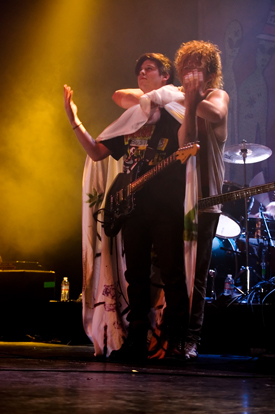 During the set, Williams took notice of a white sheet that was floating in the sea of people. It read in black messy writing, “Bluntz after show,” and was decorated with colorful cartoons of green aliens and a blue dinosaur smoking joints.
During the set, Williams took notice of a white sheet that was floating in the sea of people. It read in black messy writing, “Bluntz after show,” and was decorated with colorful cartoons of green aliens and a blue dinosaur smoking joints.
Before they broke into the song “So Bored,” bassist Stephen Pope grabbed the fan-made sheet and tied it around Williams’ neck over his black Misfits tee, just as a superhero would wear a cape.
Wavves decided to end their punk spree with their hit “Post Acid” that turned the crowd into jumping animals. To end the final note of the song, Williams launched his guitar straight toward the drum set and casually walked off stage.

Best Coast
Afterward, Best Coast walked out to make their second return to Noise Pop, but this time as a headlining band and in front of hundreds more faces. The band started off playing the first few tunes with careless ease until they had trouble starting off one of their new songs.
“I smoked too much weed today,” said frontwoman Bethany Cosentino with a smile and her guitar at hand. So the band decided to skip the song altogether and soon realized that the other members, (bassist) Bobb Bruno and (dummer) Ali Koehler, had different set lists all together. But that didn’t slow the indie rockers from continuing their summer-loving set.
Best Coast pleased the crowd and played through most of their songs that are on their debut album, Crazy for You. Even though the fans were packed indoors like sardines, it felt as if they were taken to the sandy beach to rock out.
When Cosentino broke into the song “Boyfriend,” a young man in the audience was caught lip-synching every word of the song, almost in a trance while he watched the headliners perform within feet of him.
We all know summer can’t last forever. But Best Coast and Wavves brought the warm, carefree feelings of summer just for those few hours during Noise Pop.
Pets Return to “Kill The Boredom” For Second Album
Most people watch TV and play video games in their living room, but Allison Jones and Derek Fieth of the rock band Pets use their house space a little differently. For the past few years, the rock couple has used their living room as an area to practice their music for upcoming gigs and recordings.
“Our living room is set up so one side is a couch and the other side is all of the amps and guitars set up against the wall,” said Fieth with a laugh. “So when it’s time to practice we have to drag it out, like we are setting up for a show. It’s not that big of a deal. It’s great to practice at home but it does make it a bit of an event.”
Although they would like to have a separate music room in their home to rehearse in, the only thing they seem to need is each other to begin the creative flow.
“He just doesn’t write a song and then I am like, ‘OK show me how to play it,’” explained Jones. “We write at the same time.”
But after much practicing, Pets are ready to unveil their second album, Ready the Rifles with 10 new tracks that will turn your mundane day into a rock out session. At first, they chose their album name because it simply sounded cool, but Jones and Fieth soon realized that the title had more meaning than they thought.
“The ‘rifles’ are whatever you use or we use to kill the boredom,” Fieth said. “So it’s like a call to action…your rifles kill the boredom. The last song is called ‘Bored to Kill’ and that’s what the whole thing is kind of about. If you’re bored, then make it better.”
The amount of footwork Pets put into their new CD could make them one of the hardest working bands in the area. The guitar players made sure that every part of their new album, from the artwork to the packaging, was under their control.
“It was cool to be so hands-on with the company making the CD though,” said Fieth after sipping his $1 Olympia beer. “It just shows that anybody can do it, if they get into it and go for it.”
Both band members agreed that if you mixed the music from The Raveonettes and Black Rebel Motorcycle Club it would equal their new rock sound for Pets’ upcoming album.
Ready the Rifles is fully equipped with live drums and has a “straight rock ‘n’ roll” feel to it, compared to their debut album Pick Up Your Feet, which prominently featured a synthesizer and a drum machine. These days, the duo decided to drop the old drum machine and only play with a live drummer for all of their shows.
“So that’s a big difference. It’s always going to be a live band from now on, which is fun,” said Fieth. “We love the drum machine, but we had pretty much had that machine run its course… But the energy playing with live drummers is awesome, especially with the new songs.”
“There’s obviously extra energy on stage,” added Jones.
Pets recorded Ready the Rifles with Ira Skinner at Alley Avenue Studios and hope to book him for future shows as their drummer.
“We would have had to buy a new [drum machine] and learn how to use it,” Fieth stated. “Or hire a regular full time drummer, but we love being just a two-person band. We don’t want to officially have a third member.”
One of their personal favorite tracks on the new album is “Sweetspot,” because it only took them about two afternoons to put together, unlike some of their other songs which took them months to produce.
Both members are Sacramento residents. Jones, from Citrus Heights, and Fieth, from Yuba City, feel like they have played at almost every local venue such as Old Ironsides, Marilyn’s, Press Club, The Distillery, Luigi’s, The Blue Lamp and even Sacramento State. But with the rapidly changing music scene in Sacramento, booking shows for their new music might be a different experience for Pets.
“When we had the drum machine it seemed like sometimes people didn’t know where to put us on a show,” said Fieth. “Now we’ve got this full, loud, rock ‘n’ roll set up. So we’re excited to see what happens.”
In 2010, Pets were pleasantly surprised to win the Sacramento Area Music Award (The Sammie) for “Outstanding Pop,” because they have been nominated multiple times but in different music categories.
It took Pets five years between their two albums, because they never feel the need to force the music out of their heads. They only play rock ‘n’ roll to have fun.
“If it gets hard, then we kind of put it off,” Fieth said.
“We go out instead,” continued Jones.
Even when choosing a band name in the summer of 2003, they decided to keep things short and sweet.
“We made a few simple rules,” said Fieth. “We wanted something that didn’t tell you what kind of music it was going to be. A lot of bands you can tell what you are going to hear just by reading the name. Pets was pretty unassuming.”
But when the fun-loving rockers aren’t on stage, they enjoy a good night out on the town in Sacramento’s downtown grid, mini vacations to San Francisco, and taking care of their pet cat named Townes. They even like refer to themselves as local “happy hour hounds.”
“We can tell you all the good happy hours,” said Jones. “We would have moved if Sacramento wasn’t so good… If there were no downtown, we wouldn’t be living in Sacramento. It’s comfortable, it’s nice.”
When the duo is on stage playing their loud rock set, it is easy to expect both members to be full of delicious pizza every time they perform. When it is show day, Pets have their pre-show ritual food at their weekly downtown eatery, Pete’s Pizza.
Whether its happy hour hunting or guitar practicing in their living room, Pets’ are ready to rock Sacramento and Ready the Rifles definitely won’t kill anyone from boredom, with their raw guitar sounds, synchronized vocals and live drumbeats.
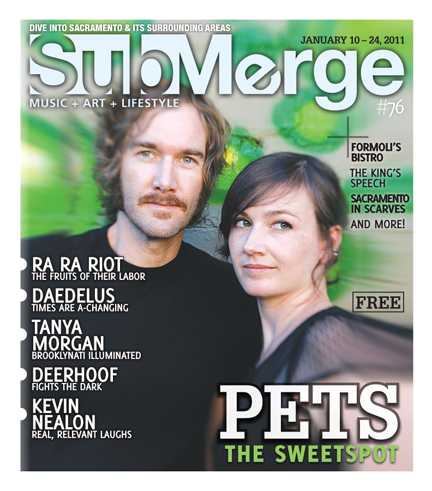
If you are 21+ and missed their all ages CD release show at Luigi’s Fungarden in Jan. you can see them this coming Friday Feb. 4 at the Townhouse. Show starts at 9 p.m. with DJ SAMiJAM, Shaun Slaughter, Adam J, Taylor Cho and Roger Carpio.

